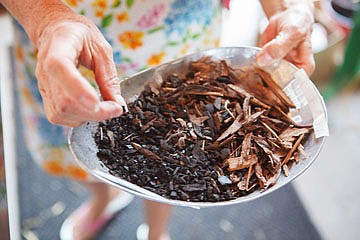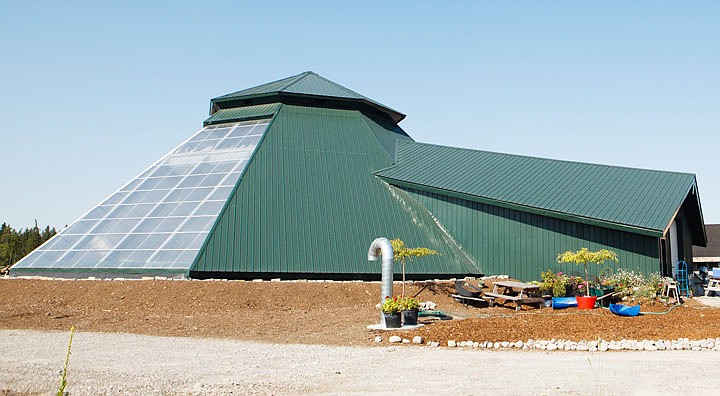Green power
A giant greenhouse facility in which the regenerative processes of Mother Nature are imitated to create electricity, biofuel, rich organic soil fertilizer and a year-round food harvest will celebrate the official beginning of production with an open house and celebration on Aug. 23.
Algae Aqua-Culture Technology laid the foundation for the 5,000-square-foot self-sustaining dome behind F.H. Stoltze Land and Lumber Co. of Columbia Falls in 2010, and since then the completion of the “Green Power House” has fulfilled the vision of founder Michael Smith to convert waste gas emissions and biomass into usable products.
The tour of the facility, which houses eight water runways full of energy-rich algae in a three-story building of glass and concrete, runs from 5:30 to 7 p.m. There will be a 6:15 p.m. dedication of the building in the memory of Lt. Gen. Richard “Dick” Swope, an avid supporter and founding board chair of the enterprise. He died in January 2011.
Robin Kelson, vice president of corporate development, has led many tours of the greenhouse already and hopes to encourage further local education, especially through school programs. The facility, which offers employment to 10 people, was initially funded with a $350,000 grant from the Montana Department of Environmental Quality.
The plant will sustain itself financially through the sales of soil amendments created through a mix of biochar, the organic carbon created from pyrolysis of waste biomass, and algae digestate. The soil amendments will be sold as fertilizer for home gardeners and for potting soil.
“It’s the right ratio of carbon to nitrogen, and mimics a fertile organic soil,” Kelson said. “It helps kick-start the rebuilding of soils.”
The soil enhancement component is what drew Kelson, whose background is in biochemistry and biotechnology patent law, to the project. She is a fervent believer in the mission of soil conservation and regeneration, as she said the United States is losing soil at 10 times the rate it takes to regenerate.
“This is a huge issue that’s just around the corner,” she said.
It’s also the best way for the greenhouse to keep itself in business. The fertilizers can be sold for around $8 a pound, and the plant generates two tons of biochar a week. The investment in the “hog fuel,” or waste products, from Stoltze is at the most $40 a ton.
“It’s a huge return on our investment,” Kelson said. “It’s what allows this to be an attractive incentive for alternative energy.”
Though Algae Aqua-Culture does not plan to sell electricity locally, the power from the Columbia Falls facility could run 100 homes, which would save $264,000 a year at the U.S. national average of 12 cents a kilowatt hour. In places like Hawaii, where kilowatt hours are soon likely to reach 60 cents, it would offset about $1 million worth of electricity in a year.
Organically grown plants thrive in the facility, and a vertical farming plan featuring a Ferris wheel-like rotating structure is the current plan. The plants also create a dappled environment for the algae, which does not appreciate a steady diet of full sun.
The production keys on the algae, grown in raceways that mimic natural streams.
“Algae is one of the most energy-rich plants,” Kelson said. “If it were grass, you would have to mow it three times every 24 hours.”
Carbon dioxide, pulled from the hog fuel, is pumped into the water to fuel algae growth. While the Columbia Falls site uses the Stoltze leftovers, the biomass can come from all sorts of natural waste, Kelson said, from cornstalks to beetle-killed trees.
The algae fueled by the waste biomass is fed to digesters, which extract methane gases,
as well as algae “manure.” One pound of algae will produce 1,000 more BTUs than 1 pound of coal.
Though Kelson said Stoltze is highly efficient with the wood it mills, it still leaves behind between 100 and 150 tons of residual waste materials each day. The pyrolisis process heats up the waste matter wood in the absence of oxygen, and the algae will consume the carbon dioxide from six tons of hog fuel a day. The pyrolisis also produces bio-oils and syngas. It is super efficient, as wood that takes 400 years to degrade can be turned into carbon that goes back to soil in 40 minutes.
The algae that circulates through the digestate process is added to the pyrolized organic carbon to create the soil restoration products that ultimately could be used to enhance agriculture, reclaim land and speed up reforestation projects.
Smith, the president and chief executive officer of Algae Aqua-Culture, has a background in physics and high-level computer graphics. He used his expertise to create an Autonomous Network Technology computer system, through which all the processes of the plant communicate to create an efficient circle of production.
“That’s a big part of how the plant can run on 5 kilowatts of electricity a day,” Kelson said. “A home runs on about 100 kilowatts.”
Kelson said as far as they know, the Stoltze Green Power House is the only facility of its kind, possibly worldwide. They would like to change this though. A turnkey Green Power House can be purchased for $1.8 million, which would pay for itself in five years. First Nations communities in remote locations in Canada, as well as some Canadian lumber mills and energy companies, have expressed the most interest. The University of Hawaii would like to create a facility as a teaching tool; the islands are full of invasive species that could be cut down and used as fuel for the greenhouse.
Algae Aqua-Culture emphasizes that the system works in all climates, creating jobs, fuel, soil and food for communities in remote locations. A grouping of six Green Power Houses (the goal for the Columbia Falls site) could power a medium-sized lumber mill or similar industry.
For more information on the Algae Aqua-Culture Technology tour, email infor@algaeaqua.com or call 862-7678. They would also like RSVPs for the tour, as participants will be shuttled to the site from a parking lot near the Stoltze office.








